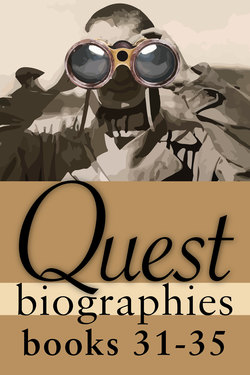Quest Biographies Bundle — Books 31–35

Реклама. ООО «ЛитРес», ИНН: 7719571260.
Оглавление
Rosemary Sadlier. Quest Biographies Bundle — Books 31–35
Introduction
1. Harriet Tubman’s Beginnings
2. Wedded Bliss
3. Unearthing the Truth
4. Freedom Seeking
5. Leading Others to Freedom
6. Arriving in Canada
7. Life in St. Catharines
8. Taking the Railroad into Canada
9. The Civil War
10. Successful Activism
11. The End of the Line
Epilogue
Chronology of Harriet Tubman (Circa 1820–1913)
Selected Bibliography
Epigraph
Prologue
1. Child of the Revolution
2. Departure for Upper Canada
3. James Secord, United Empire Loyalist
4. Isaac Brock and the Battle of Queenston Heights
5. A Seasonal War
6. The Green Tiger: Lieutenant James FitzGibbon
7. The Walk to Beaver Dams
8. Ambush in the Beech Woods: The Battle of Beaver Dams
9. Aftermath
10. The Death of Tecumseh
11. The Frontier Burns
12. The Final Battles
13. Family Fortunes
14. The Move to Chippawa
15. The Widow Carries On
16. The Prince’s Gift
17. The Heroine and the Controversy
Epilogue
Chronology of Laura Secord
Bibliography
Epigraph
Introduction
1
2
3
4
5
6
7
8
9
10
11
12
Postscript
Chronology
Bibliography
Introduction
1
2
3
4
5
6
7
8
Chronology
Note on Sources
Epigraph
Foreword
Background
Introduction
Forms of address used for Prince Edward in this book:
1
2
3
4
5
6
7
Appendix A:
Appendix B:
Appendix C:
Chronology of Prince Edward
Notes
Selected Bibliography
Copyright
Отрывок из книги
This book will provide some new interpretations and information on the most notable African-American/African-Canadian conductor on the legendary Underground Railroad: Harriet Tubman. Based upon interviews with Tubman descendants, archival materials, and extant literature, this book will acquaint the reader with the experience and contribution of just one of the many notable, identified leaders on the Underground Railroad, placing her in a local, regional, international, and global context.
The Underground Railroad was the first freedom movement of the Americas and is credited with infusing Canada with a number of black people. How did it work? Where did people come into Canada? How were they treated upon their arrival? How is it that we spoke of these things in certain places and why was this missing from the education that I was receiving at school?
.....
Towards the end of 1858, Harriet moved her parents to Auburn and made her home there because of Margaret, because of the assistance of Seward — now the Governor of New York and Harriet’s strongest supporter — and because Auburn was becoming a centre for abolitionists and the women’s suffrage movement. St. Catharines may have ceased to have personal appeal to Harriet because her growing awareness of the enormity of the slave issue made her feel that a major approach in co-operation with sympathetic whites was needed in order to stop slavery and increase tolerance. Harriet may have come to realize that as important as her assistance to a small group might be, it was time to heal the problem by ending slavery. In nineteen life-risking missions, Harriet had rescued, and ensured a livelihood, for over 300 people, but there were thousands of others still suffering. Even if she spent the rest of her life conducting people to safety, she would never be able to free them all.
A movement or political reform that would end slavery had great appeal. William Seward was introduced to Harriet by Frederick Douglass. Seward was a Republican who had opposed the Fugitive Slave Act. He was close to winning a presidential election, but his stand on the John Brown issue at Harpers Ferry (a planned slave rebellion) later cost him the win. Seward was able ensure that Harriet was able to bid on the land, and some reports indicate that he loaned Harriet the money to buy property in Auburn which Harriet later repaid with the proceeds from the sale of the Sarah Bradford book, Scenes in the Life of Harriet Tubman.
.....